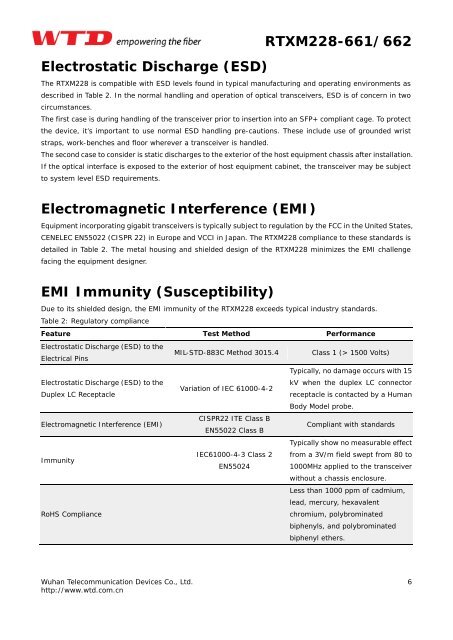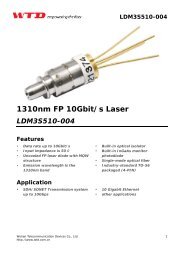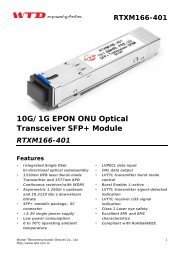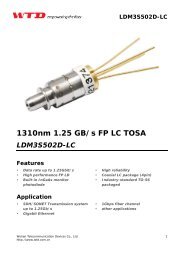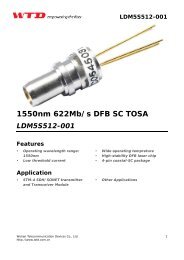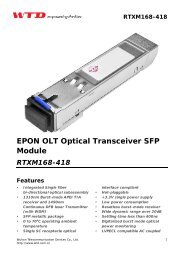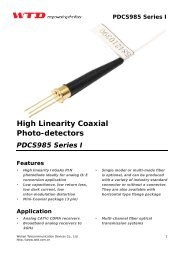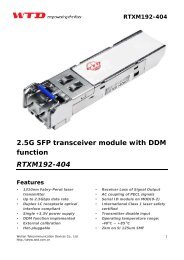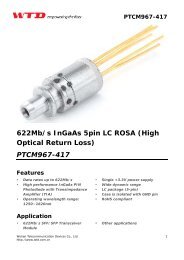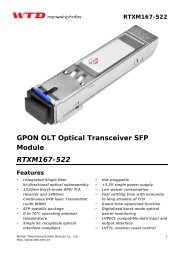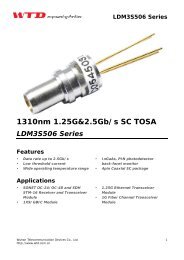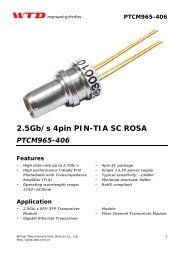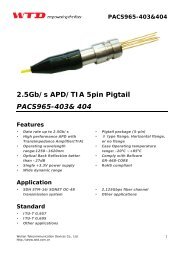RTXM228-661/662
RTXM228-661/662
RTXM228-661/662
Create successful ePaper yourself
Turn your PDF publications into a flip-book with our unique Google optimized e-Paper software.
Electrostatic Discharge (ESD)<br />
Wuhan Telecommunication Devices Co., Ltd.<br />
http://www.wtd.com.cn<br />
<strong>RTXM228</strong>-<strong>661</strong>/<strong>662</strong><br />
The <strong>RTXM228</strong> is compatible with ESD levels found in typical manufacturing and operating environments as<br />
described in Table 2. In the normal handling and operation of optical transceivers, ESD is of concern in two<br />
circumstances.<br />
The first case is during handling of the transceiver prior to insertion into an SFP+ compliant cage. To protect<br />
the device, it’s important to use normal ESD handling pre-cautions. These include use of grounded wrist<br />
straps, work-benches and floor wherever a transceiver is handled.<br />
The second case to consider is static discharges to the exterior of the host equipment chassis after installation.<br />
If the optical interface is exposed to the exterior of host equipment cabinet, the transceiver may be subject<br />
to system level ESD requirements.<br />
Electromagnetic Interference (EMI)<br />
Equipment incorporating gigabit transceivers is typically subject to regulation by the FCC in the United States,<br />
CENELEC EN55022 (CISPR 22) in Europe and VCCI in Japan. The <strong>RTXM228</strong> compliance to these standards is<br />
detailed in Table 2. The metal housing and shielded design of the <strong>RTXM228</strong> minimizes the EMI challenge<br />
facing the equipment designer.<br />
EMI Immunity (Susceptibility)<br />
Due to its shielded design, the EMI immunity of the <strong>RTXM228</strong> exceeds typical industry standards.<br />
Table 2: Regulatory compliance<br />
Feature Test Method Performance<br />
Electrostatic Discharge (ESD) to the<br />
Electrical Pins<br />
Electrostatic Discharge (ESD) to the<br />
Duplex LC Receptacle<br />
Electromagnetic Interference (EMI)<br />
Immunity<br />
RoHS Compliance<br />
MIL-STD-883C Method 3015.4 Class 1 (> 1500 Volts)<br />
Variation of IEC 61000-4-2<br />
CISPR22 ITE Class B<br />
EN55022 Class B<br />
IEC61000-4-3 Class 2<br />
EN55024<br />
Typically, no damage occurs with 15<br />
kV when the duplex LC connector<br />
receptacle is contacted by a Human<br />
Body Model probe.<br />
Compliant with standards<br />
Typically show no measurable effect<br />
from a 3V/m field swept from 80 to<br />
1000MHz applied to the transceiver<br />
without a chassis enclosure.<br />
Less than 1000 ppm of cadmium,<br />
lead, mercury, hexavalent<br />
chromium, polybrominated<br />
biphenyls, and polybrominated<br />
biphenyl ethers.<br />
6


